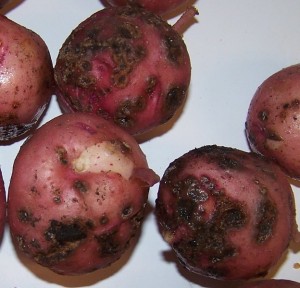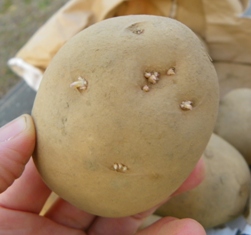Time to Plant Potatoes
go.ncsu.edu/readext?274259
en Español / em Português
El inglés es el idioma de control de esta página. En la medida en que haya algún conflicto entre la traducción al inglés y la traducción, el inglés prevalece.
Al hacer clic en el enlace de traducción se activa un servicio de traducción gratuito para convertir la página al español. Al igual que con cualquier traducción por Internet, la conversión no es sensible al contexto y puede que no traduzca el texto en su significado original. NC State Extension no garantiza la exactitud del texto traducido. Por favor, tenga en cuenta que algunas aplicaciones y/o servicios pueden no funcionar como se espera cuando se traducen.
Português
Inglês é o idioma de controle desta página. Na medida que haja algum conflito entre o texto original em Inglês e a tradução, o Inglês prevalece.
Ao clicar no link de tradução, um serviço gratuito de tradução será ativado para converter a página para o Português. Como em qualquer tradução pela internet, a conversão não é sensivel ao contexto e pode não ocorrer a tradução para o significado orginal. O serviço de Extensão da Carolina do Norte (NC State Extension) não garante a exatidão do texto traduzido. Por favor, observe que algumas funções ou serviços podem não funcionar como esperado após a tradução.
English
English is the controlling language of this page. To the extent there is any conflict between the English text and the translation, English controls.
Clicking on the translation link activates a free translation service to convert the page to Spanish. As with any Internet translation, the conversion is not context-sensitive and may not translate the text to its original meaning. NC State Extension does not guarantee the accuracy of the translated text. Please note that some applications and/or services may not function as expected when translated.
Collapse ▲ Potatoes are one of my favorite crops to grow in the spring garden. No matter what your age, nothing is more fun than digging potatoes from the soil – it’s like a tiny treasure hunt! And the taste of home grown potatoes is outstanding.
Potatoes are one of my favorite crops to grow in the spring garden. No matter what your age, nothing is more fun than digging potatoes from the soil – it’s like a tiny treasure hunt! And the taste of home grown potatoes is outstanding.
When and Where to Plant Potatoes
Potatoes planted in February will be ready to harvest in May and June. For best results, plant only certified seed potatoes, which can be purchased from garden centers this time of year. Certified seed potatoes are small potatoes that have been grown under special conditions to ensure they are free of diseases and usually give better results than potatoes purchased from the grocery store.
Potatoes need to be planted in rich, well drained soil. Wet soils often result in disease problems and crop failure. To yield well, potatoes require consistent moisture and prefer rich soils that have been well amended with organic matter such as rotted horse manure or compost, and have a soil pH of 5.5 to 6.0. Learn how to have your soil pH tested.
Potatoes grown in dry sandy soil and soils where the pH level is over 5.5 are more prone to potato scab, a bacterial disease that causes brown, corky scabs to form all over the potato skin.
How to Plant Seed Potatoes
Potato varieties that do well in our area include ‘Yukon Gold’, a personal favorite with creamy, gold color flesh, ‘Kennebec’, and ‘Red Pontiac’, a red skin potato with white flesh and deep eyes. Cut seed potatoes into pieces that are each about the size of an egg and contain at least one sprout, known as an ‘eye’. Cut pieces can be planted immediately or sprouted indoors for a few weeks by placing them in a warm, sunny location.
In the garden, plant seed pieces 6” deep and 10” apart in the row, with 3’ between rows. Keep in mind 12 pounds of seed potatoes can plant around a 100’ row, and yield over 200 pounds of spuds. Once harvested potatoes can be stored in a cool, dry, dark place such as a garage or shed, where they will keep for three to four months or more.
As potatoes grow, keep an eye out for their worst enemy, the Colorado potato beetle. Most years, adult beetles emerge in our area in late April and begin laying clusters of bright orange, football shaped eggs on the back of potato leaves.
Take the Year Round Gardening Challenge!
I have a challenge for you: Grow at least one type of vegetable in each season. It’s not as hard as it sounds. Vegetables can be grown outside in southeastern NC from late winter through late fall. North Carolina Cooperative Extension Year Round Gardening Challenge
Learn More!
Potato: Home and Garden Information Center, Clemson Extension
Visit your local Cooperative Extension office to learn more about gardening and landscape care. Go to https://www.ces.ncsu.edu/local-county-center/ to find your county Extension center to talk to a Horticulture Agent.
To contact your local N.C. Cooperative Extension office in southeast North Carolina call…
- Pender County, call 910-259-1235
- New Hanover County, call 910-798-7660
- Brunswick County, call 910-253-2610
- Onslow County, call 910-455-5873
- Duplin County, call 910-296-2143
- Bladen County, call 910-862-4591
Visit the Pender Extension Lawn and Garden webpage to stay up to date with all the latest gardening news.





